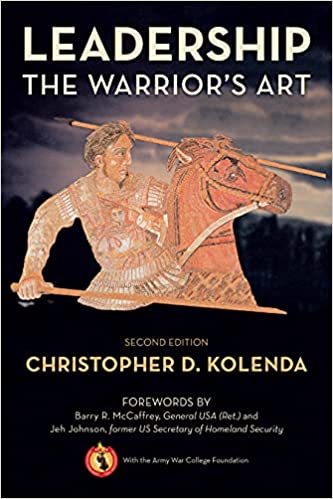Reviewed by Rhonda Smith-Daugherty, Ph.D.
In his famous work, On War, Carl von Clausewitz discussed the qualities that make up what he termed the “Military Genius.” While he acknowledged that good leaders require intellect, the real heart of leadership is intuition and courage. Since the battlefield is fluid, a leader must have the ability to counter whatever tactics the enemy uses, while never losing site of the objective. He or she, must gauge the enemy’s path using information obtained during the battle. This information may be incomplete or even false, but a good leader acts on the intuitive and sees through the “fog of war.” The leader’s courage and determination ultimately wins the battle since the spirit of the leader is infused in the troops. “Courage,” Clausewitz wrote, “above all other things is the first quality of a warrior.” Leaders can acquire these skills by studying the campaigns and generals of the past. One such recent work, which analyzes both ancient and modern military campaigns is Christopher Kolenda’s Leadership: The Warrior’s Art.
Leadership: The Warrior’s Art is a book highly praised by the U.S. Army. It is a book written for the Army largely by the Army. The editor and author of the first chapter, Christopher D. Kolenda, is a West Point graduate, retired Army colonel and veteran of the Afghanistan conflict. The book is recommended by the Association of the Army and includes forewords by a former U.S. Secretary of Homeland Security and a retired U.S. Army General. The introduction, written by a retired U. S. Army Lieutenant General, stresses the importance of studying leaders and actions and the circumstances which made them into leaders. The book is also praised by the late Gen. Harold Moore, hero of the 1965 Ia Drang Valley battle, who called the work the “absolute best book on military leadership.” Meanwhile, retired Marine General Joseph Dunford described the book as “a must read for military leaders navigating the challenges of the post 9/11 era. “
The book includes 22 chapters which explore many different topics relating to the art of leadership and warfare. Ancient and contemporary military strategies are examined as well as Army doctrine and how to create and maintain cohesion among soldiers. Each chapter begins with a summary and ends with “Action Steps,” suggestions that the Army could adopt. The book includes endnotes and an index but no bibliography. Authors of the chapters include current and retired Army officers and military historians, such as the late Dennis Showalter.
The book is divided into three sections. Section I is entitled “The Ancient and Modern Concepts of Leadership” and includes chapters on defining leadership and role of good leadership in building cohesion among the soldiers. Section II is entitled “Historical Case Studies,” and analyzes the leadership qualities of Alexander the Great and Frederick the Great. The section also includes chapters on individual soldiers in World War I, World War II, the ethics of total war in relation to bombing campaigns in World War II and Soviet doctrine in the inter-war period. The third and final section is titled “Contemporary Experiences and Reflections on Leadership.” Daniel W. Christman’s chapter on “Twenty-First Century Leadership,” examines the “minefield” of modern warfare where the battlefield may be technological or covert rather than sending armies into the field. Warriors must also prepare for peacekeeping missions and disaster relief missions, which involve respecting and understanding the civilian population. The last three chapters deal with unresolved issues in the modern army, including the acceptance of women soldiers and transgendered individuals, the dangers of sexual harassment and hazing and, the importance of respecting others’ ideas and cultures.
Overall, the book examines leadership from several perspectives. Case studies are in-depth and examine how diverse warriors have faced military challenges in Ancient Greece, Empirical Germany, the world wars and contemporary battlefields. A recurring theme is how the quality of leaders directly affects those who are led. The book stresses that a leader should follow a moral compass. Leadership qualities include courage, willingness to take the initiative and the ability to inspire and motivate troops. Furthermore, a leader who shares the same hardships as the troops gains respect. In addition, a leader who sees everyone on the team as an essential member, transfers that idea to the troops. Soldiers learn by example and if a leader is dismissive or condescending to part of the team, other soldiers will adopt this behavior. Soldiers will also follow a leader who believes in the cause and doesn’t put their lives in unnecessary danger. The book also stresses the importance of education, training and experience to mold great leaders.
Finally, Leadership: The Warrior’s Art examines the role of technology on the battlefield and its effects on leadership. The authors recognize that technology will continue to evolve and influence the planning and outcome of war as well as the conduct of soldiers in battle. The authors and editors, however, leave some unanswered questions that include: Is it easier to rationalize killing if the enemy is only a blip on a screen? Or, how much participation will the human soldier have in battle if drones and robots take over warfare? Also, how will leadership tactics evolve in the technological battlefield?
The book could be used in a leadership course or a graduate level military history course. Undergraduate students would flounder with the scope and depth of the book. Students would need a solid background in ancient and contemporary military history in order to comprehend the chapters. They would also need some background in military tactics and terminology, thus the book is more suitable for junior or senior level students attending mid-level and senior professional schools.
Dr. Rhonda Smith-Daugherty is a Professor of History at Alice Lloyd College.
Leadership: The Warrior’s Art. Ed. by Christopher Kolenda (Guilford, CT: Stackpole Books, 2021).


